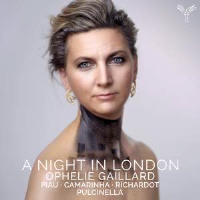Texte paru dans: / Appeared in: |
|
|
Outil de traduction |
|
|
While mention of the Baroque cello repertoire might first prompt thoughts of Italy, the title of this programme from Ophélie Gaillard is enough to pique interest. Underpinned by her emotional connection to England (including a student appearance at the Manchester International Cello Festival, where she met János Starker among others), Gaillard – directing her own period-instrument Pulcinella Orchestra from the cello – uses her instrument as the linking theme in a multigenre cornucopia of works honouring 18th-century London’s attraction for musicians of all nationalities, including many leading Italian cellists. Among these Giovanni Battista Cirri emerges as a further guiding light. Born in Forlì in 1724, Cirri arrived in London in 1764 as chamber musician to the Duke of York and director of music to the Duke of Gloucester, but his musicmaking stretched far beyond private palaces. A favourite across the capital as both cellist and composer, he was renowned for his versatility that saw him playing chamber music or accompanying singers as well as performing cello concertos during opera intervals, after which he’d frequently end up in the tavern for further lower-brow music-making. Cirri is most obviously celebrated here in such a work intended for an opera interval, his Cello Concerto No 2 in G – a suavely virtuoso number that Gaillard performs on her 1737 Goffriller with mellow-voiced lyricism and lithe agility to lightly springing orchestral support, retaining a rounded softness even in the upper-register lines of the central Largo assai. From there we jump to variations on popular folk tunes by Scottish cellist James Oswald, who moved to London in 1741 and was chamber composer to George III. These offer a whole fresh bag of pleasures, moving from the dancing ‘The Murrays March’, complete with percussion and guitar, to the sombre serenity of ‘My Nanio’, before the ensemble reprise of ‘She’s sweetest when she’s naked’, which Gaillard first presents at the top of the programme as a haunting solo-cello teaser. Gaillard’s folky inflections and multi-hued articulation are seductive in the extreme, and second time around there’s the added gift of up-tempo further variations led with rich-toned soul by violinist Pablo Valetti. Which leads me to Gaillard’s various collaborators. Space precludes mentioning all their contributions but they’re each to be savoured for their individual flavours. Handel’s ‘Credete al mio dolore’ is especially beautiful for the tender duetting between Gaillard and Sandrine Piau, not least as the golden purity of Piau’s soprano tones strikingly complements Gaillard’s own tones. The recording, made in Paris’s Temple Saint-Pierre, is eminently natural and warm. |
|




